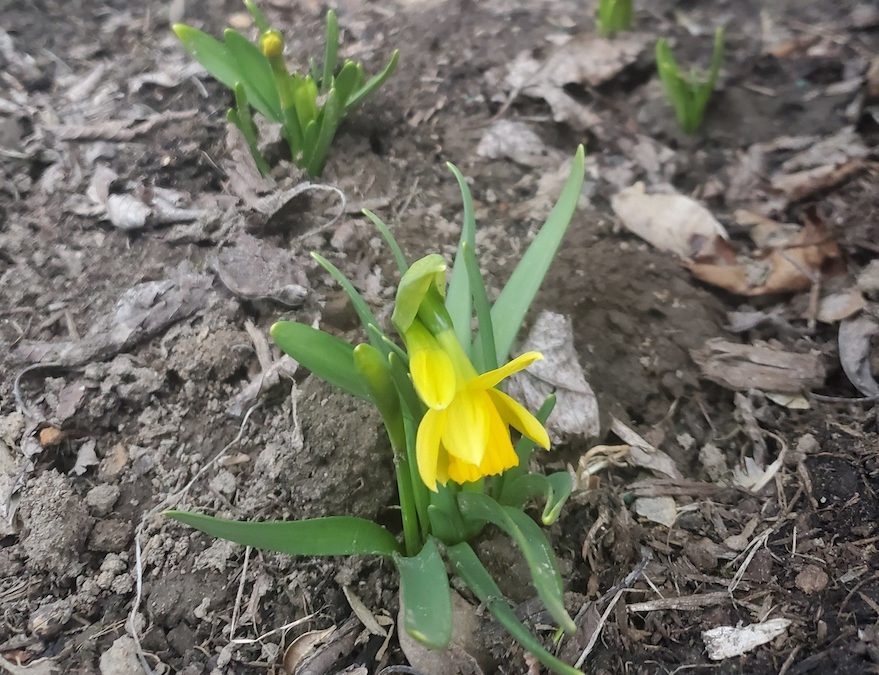Is it possible to stay calm enough to function well when the world is in tough shape—while still honoring real fear and distress? Yes. Read on for a simple but powerful way to ground yourself in your body and create a sturdy container to hold even intense feelings.
COVID-19 truly hit Rochester on March 11. That’s when we got serious about social distancing. Since that day, my life has felt surreal. I still get up, meditate, exercise, and work, doing my best to keep my routines, but in a flexible way. These activities help to ground me. But on a deeper level, everything feels different. Even for a highly sensitive person, I’m holding much more in my body than usual. All these emotions can start to feel like the planes circling O’Hare in bad weather: all stacked up with nowhere to land.
I could try to divert these emotional “planes” to other airports. But I find that while diversion and distraction can be effective strategies for passing emotions like frustration over a long wait in line or craving a second bowl of ice cream, they don’t work with my deeper, more complex pandemic-related feelings. These feelings won’t be denied. If I push them away, they simply come back, carrying a bigger baseball bat to hit me over the head with.
How do we honor real fear and distress, without getting overwhelmed?
The truth is, my emotions are messengers. To hear their messages, I need an inner container sturdy enough to handle a wide variety of feelings—from gratitude and compassion to anger, sadness, and uncertainty.
I had been wondering where could I find a simple, sturdy, portable process that could help me hold this ever-changing swirl of emotions when the answer came to me during my weekly Focusing partnership exchange with my friend and colleague Katherine Kehoe. Inspired by the coronavirus breathing down our necks, the two of us realized we had a body-grounding process right in front of us that is perfect for this challenging time.
I’m calling it the Four-Resource Body Grounding. On its own, this five-minute process can help you hold intense emotions within a bigger container of calm. I use it when I want to create a particularly sturdy sense of presence in myself before doing inner work. I also take myself through the process when I’m out on my daily walk. In that case, I use it simply to tap into and savor any feelings of spaciousness and well-being that are in my body.
How the Four-Resource Body Grounding works
This five-minute process grounds you so you can be present with yourself and others—even when your inner guests are throwing around the furniture. When you are present in this way, your emotions settle down.
Even better, it helps counteract the negativity bias to which all of us are subject. We are wired to notice problems, causing us to overlook the very resources we need to address those problems. The Four-Resource Body Grounding counteracts negativity bias by helping you notice and acknowledge any way in which you feel OK in this moment, creating a ground of well-being within which you can hold your intense emotions.
This deceptively simple process is—
- Powerful. By tapping into four diverse resources, you create a spacious, sturdy container of Presence, allowing you to hold your intense feelings with radical acceptance
- Adaptable. As Katherine puts it, “If one resource doesn’t work for you, another one will.”
- Spiritually inclusive. Highly sensitive people express our spirituality in widely diverse ways. This process invites you to connect directly with the energy of Spirit if you wish, without requiring you to do so.
- Flexible. You can do the body grounding silently or out loud, alone or with a partner.
You can download a printable PDF of the Four-Resource Body Grounding here. Or listen directly to the MP3 version:
Setting the stage for a better inner relationship
The four resources you martial in this process enable you to hold even your most intense feelings in a container of radical acceptance. In this way, you can honor your fear and distress—without getting overwhelmed. With this sturdy inner container, you can develop a new relationship with your emotions. You can learn how to treat them as guests, and hear their messages. Your acceptance sets the stage for them to shift when they are ready.
All these steps are part of the Focusing process. If you are interested in learning to Focus, please email me: I’m contemplating teaching the six-week Focusing 1 for Sensitive People course soon.
In the meantime, the first and most important step of Focusing is to create space in yourself in the moment so you can be present and curious. With the Four-Resource Body Grounding, you can do just that. I share it with gratitude to Glenn Fleisch, the Wholebody Focusing teacher who taught Katherine and me the process upon which this one is based.
Image credit: ©2020 Emily Agnew




















This is so helpful for me. I have been struggling with overwhelm and this feels like finding an important resource for those times. I really appreciate that you shared this Emily.
I’m happy to hear this is helpful, Bianca. I ended up memorizing this…it doesn’t have to be word-for-word: you just need to be sure to cover all four resources, and to remember to bring any good feelings with you as you go so you can ground yourself in them…otherwise they have a way of being overlooked.